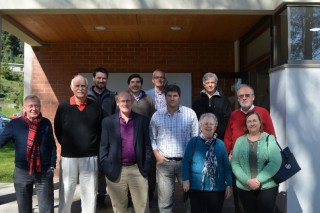
A group of representatives of LLAMA Project meets with CePIA researchers
International scientists are in Concepción to close a collaboration agreement with the Centro de Instrumentación Astronómica, CePIA of the Universidad de Concepción, which aims to launch the LLAMA radio telescope in Argentine territory that will work together with the antennas of Radio Observatory ALMA to form a network of telescopes in Latin America.
A group of representatives of the LLAMA project, an acronym for Large Latin American Millimeter Array, visited the Departamento de Astronomía UdeC, to meet with Dr. Rodrigo Reeves, director of the Centro de Instrumentación Astronómica CePIA. The LLAMA project is an international collaboration led by the University of Sao Paulo in Brazil and the Instituto Argentino de Radioastronomía (IAR) based in the Province of Buenos Aires, Argentina. 12 officials of this institution are to meet in Concepción to discuss advances and new alternatives for the project implementation.
The CePIA laboratory collaborates with LLAMA in the development of various instruments necessary for the operation of the radio telescope, for example, the system of calibration loads allows scientists to receive data in a useful physical units for interpretation, the water vapor radiometer will provide the means to correct the atmospheric effects in interferometric mode, and possibly also a system of holographic measurement to determine deviations of the antenna's surface from the ideal form that this should have, i.e. a perfect parabola.
While the long-term goal of LLAMA is the installation of a network of radio telescopes in Latin America, in order to maximize the sensitivity of the instrument and the ability to identify small scale structure in the sky, the current and more urgent goal is the assembly and commissioning of the first telescope of this nature. The place chosen by the LLAMA team for installation of this first element is at 4800 meters above sea level in the argentine altiplano, near the town of San Antonio de los Cobres. Constructively, this first radio telescope is similar to one of the ALMA antennas, however this one includes a modification of the original design that grants the flexibility to incorporate scientific instruments of different nature, and use some simultaneously, which increases markedly the system efficiency.
CePIA is led by Professor Rodrigo Reeves and accompanying him in these activities are students from various disciplines of science and engineering at undergraduate, master and doctoral level.





